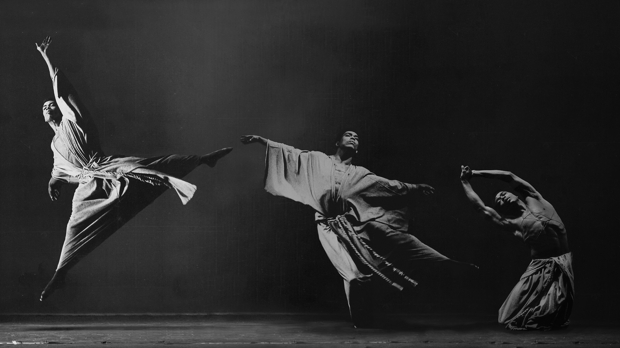 Back to selection
Back to selection
“It Was Important Always to Keep the Spirit of Dance”: DP Naiti Gámez on Ailey
 Ailey. Courtesy of Sundance Institute
Ailey. Courtesy of Sundance Institute Jamila Wignot’s Ailey explores the life of seminal choreographer Alvin Ailey in poetic manner. With a heartbeat as studied as Ailey’s jazz-dance that made him famous. DP Naiti Gámez tells us about the magic of capturing dance on film, and the ephemerality of shooting with no possibility of retakes.
Filmmaker: How and why did you wind up being the cinematographer of your film? What were the factors and attributes that led to your being hired for this job?
Gámez: I’m not entirely sure, actually. I don’t remember. ;)
Filmmaker: What were your artistic goals on this film, and how did you realize them? How did you want your cinematography to enhance the film’s storytelling and treatment of its characters?
Gámez: It was important always to keep the spirit of dance, and Ailey’s energy, in our approaches to the filming. For the dance rehearsals, we really focused on capturing the nuances of the bodies and the flow of the dancers’ interactions with one another. They are the new generation of Ailey’s legacy, so showing their power as a group, as a movement, was pivotal. For the sit-down interviews, we knew we wanted the sets and subjects to really shine and feel majestic. We wanted their stories to feel elevated and dramatized, yet contextualized within the world of so much archival footage. So, we decided on a look that could bridge the worlds of archival performances, the modern day rehearsals and his friends’ and collaborators’ memories. These sets we created became our imagined, hyper-stylized version of what “backstage” behind an Ailey production would look like: with props, cloths, grip equipment and pieces of the set framing them.
Filmmaker: Were there any specific influences on your cinematography, whether they be other films, or visual art, of photography, or something else?
Gámez: Yes, I’m always looking at photographers’ work. And I’ve DPed other projects about artists and dancers, because I love capturing artists’ creative processes. But, our director, Jamila Wignot, really spearheaded the look of this film. She came in with strong and bold stylistic references right out of the gate. She brought Al Malonga (our production designer) and I a few style references from photographers Clayton Cubitt & Awol Erizku. Not to replicate the looks, but to tease out of them what we found so moving about them: approaches to color, bold pairings, textures, etc. And we also referenced the production design from some of Ailey’s staged performances, and then brought all of those elements together to create a look that was specific to the world our characters were inhabiting. We couldn’t have developed such amazing sets without Jamila’s clear vision, and Al’s talent in translating that. We really worked hard to bring some beauty and magic and flare to these interview setups that felt unique and cohesive and still grounded within the story we were trying to tell.
Filmmaker: What were the biggest challenges posed by production to those goals?
Gámez: Executing the look for these interviews was definitely the biggest challenge. Highly stylized interviews require having lot of set design elements and the space to set them up and light them, which is always a challenge with tight budget constraints.
Filmmaker: What camera did you shoot on? Why did you choose the camera that you did? What lenses did you use?
Gámez: We shot on Canon C300 MKII and the MKIII. The Canon CN-E Cine primes, CN-E 30-105mm zoom & a few L-series lenses for the vérité. We wanted nimble and affordable documentary cameras and lenses that would allow us to film dancers, rehearsals and subjects in any setting and not be encumbered by the process.
Filmmaker: Describe your approach to lighting.
Gámez: We chose very simple lighting scenarios for the interviews: a large soft key source and rim light to shape our subjects, and pools of light to let some of the elements fall off to darkness around them.
Filmmaker: What was the most difficult scene to realize and why? And how did you do it?
Gámez: Shooting the vérité dance scenes were very challenging because we were only able to film dancers during their actual rehearsals and not interfere with the process at all. This meant there were no specific dancing for camera set-ups, no redos or retakes, no being able to adjust their movements or angles to play to the camera at all, or help us work with the lighting in the room at the time. And because the rehearsals involved so many dancers, it meant we had to always stay outside of the action, on the periphery, to get our shots, so we were often farther away than we wanted to be. This, along with the harsh changes of the natural light in the room, was a frustrating challenge. But, such n inspiring one, too, since the dancers were always so amazing to watch and capture. We would roll forever watching them move and create, it was like being under a magic spell. We loved it.
Filmmaker: Finally, describe the finishing of the film. How much of your look was “baked in” versus realized in the DI?
Gámez: Then whole look was locked in during the shoot. We tried to keep our post workflow as straightforward as possible, and just lean on it to help shape and enhance, (and correct) some of the looks (and challenges) we had.
TECH BOX
Film Title: Ailey
Camera: Canon C300MKII/MKIII
Lenses: Canon CN-E Cine primes; Canon CN-E 30-105mm zoom; Canon L-series lenses.
